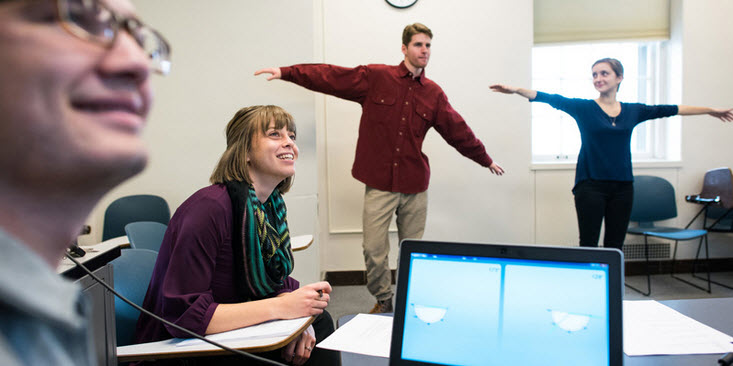Mastering math through movement using Kinect for Windows
January 27, 2015

Carmen Petrick Smith, assistant professor of mathematics education (second from left), works with undergraduate education majors on movements that are used to help elementary school children learn geometry (credit: Andy Duback)
University of Vermont assistant professor of mathematics education Carmen Petrick Smith has found in a study that elementary school students who interacted with a Kinect for Windows mathematics program while learning geometry showed significant gains in the understanding of angles and angle measurements.
The Kinect is a motion sensor input device that allows people to interact with computers based on their natural movements. Hmm, imagine what could be accomplished with a HoloLens. …

Kinect (credit: Microsoft)
Smith and her research team engaged 30 third- and fourth-grade students in a series of tasks that involved moving their arms to form angles projected on a large Kinect screen.
The screen changed colors when the students’ arms formed acute, right, obtuse and straight angles. A protractor helped students measure and refine their movements. Students were asked to figure out the hidden rules that made each of the four colors appear on the screen.
Embodied cognition and re-invention of the math class
Smith’s paper, published in the Journal of Mathematical Behavior, adds evidence to a developing area of cognitive science known as embodied cognition, which posits that the brain alone does not generate behavior, but that it actually works in concert with physical movements and other environmental and neural processes such as perception, action and emotion.
“The words of the language, as they are written or spoken, do not seem to play any role in my mechanism of thought,” said Albert Einstein. “The psychical entities which seem to serve as elements in thought are certain signs and more or less clear images which can be ‘voluntarily’ reproduced and combined…. The above mentioned elements are, in my case, of visual and some of a muscular type.” — Jacques Hadamard, The Mathematician’s Mind: The Psychology of Invention in the Mathematical Field, Princeton Press, 1996.
Instead of teachers standing in front of the class presenting angles by using static two-dimensional representations of drawings on chalkboards, Smith’s research shows that a more dynamic learning environment where students use their bodies to create angles is more effective when blended with other teaching methods. In her study, Smith found that students who focused on static representations of angles experienced less dramatic learning gains than those who participated in the movement-based lessons.
“When students are acting out a math problem and using their body to help them explain the answer, that’s another modality,” says Smith, who is using programmers to further develop the Kinect program, which she envisions in a growing number of Vermont classrooms. “Maybe they don’t know the words quite yet, but they have a way to express it using their body that they didn’t have before when they were sitting in a row of desks looking up at the teacher and searching for an answer.”
Smith helped set a world record for the most people dancing to Michael Jackson’s “Thriller” in one place at one time, and was the 2008 O. Henry Pun-Off World Champion.
Abstract of Learning angles through movement: Critical actions for developing understanding in an embodied activity
Angle instruction often begins with familiar, real-world examples of angles, but the transition to more abstract ideas can be challenging. In this study, we examine 20 third and fourth grade students completing a body-based angle task in a motion-controlled learning environment using the Kinect for Windows. We present overall pre- and post-test results, showing that the task enhanced learners’ developing ideas about angles, and we describe two case studies of individual students, looking in detail at the role the body plays in the learning process. We found that the development of a strong connection between the body and the abstract representation of angle was instrumental to learning, as was exploring the space and making connections to personal experiences. The implications of these findings for developing body-based tasks are discussed.